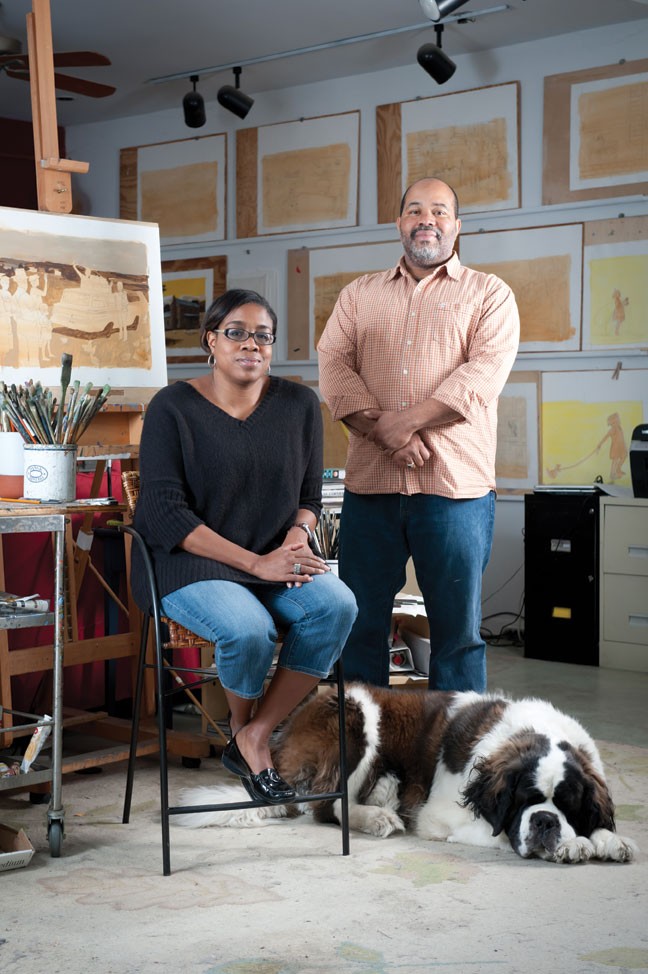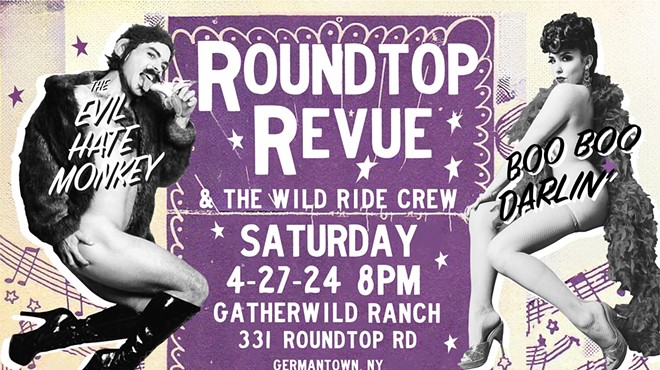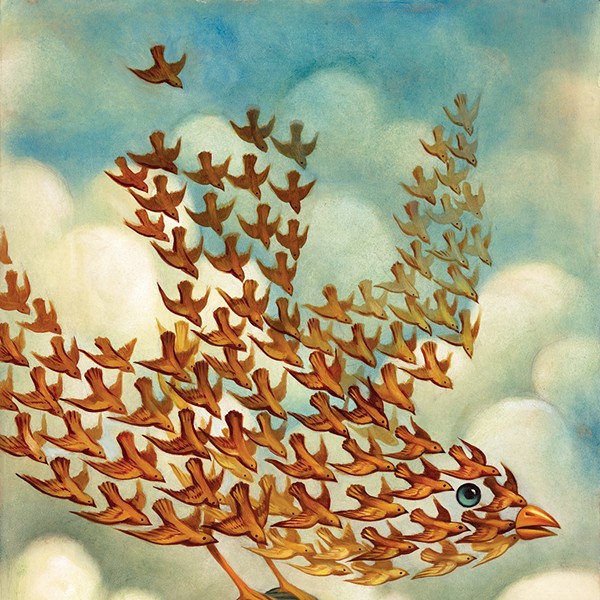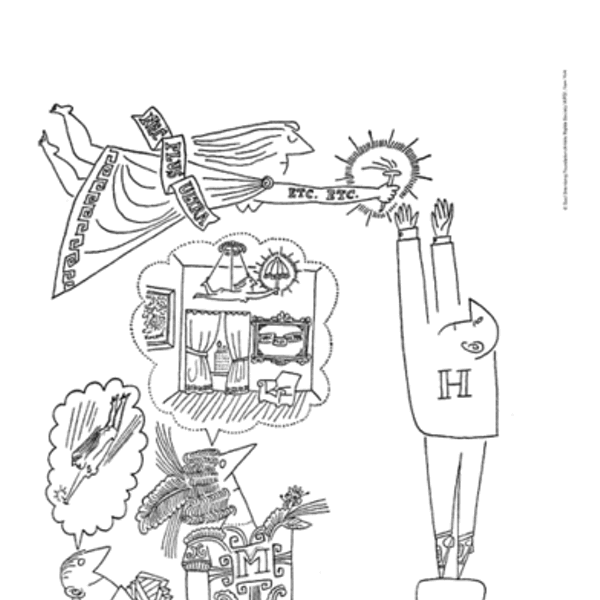Freedom Writers
The Art of James Ransome and Lesa Cline-Ransome
[]
Married author-illustrator teams are not a rarity in children’s literature, but how many can say they met their soulmate and future collaborator at a Purple Rain theme party? Illustrator James Ransome was a sophomore at Brooklyn’s Pratt Institute when he spotted a classmate at the 1985 event. “James asked me to dance, and the rest is history,” says writer Lesa Cline-Ransome. Her husband laughs, and she prompts, “You can say you thought I was cute.”
“Of course you were,” James responds with alacrity. “Not to mention your warm and charming personality.” This time both of them laugh. It’s the sound of a good marriage, of people who’ve appreciated each other’s foibles for decades.
The Ransomes just celebrated their eighth collaboration, Words Set Me Free: The Story of Young Frederick Douglass (Simon & Schuster, 2012), with a double-barreled book launch at Rhinebeck’s Oblong Books & Music; James’s paintings also grace Margaret King Mitchell’s just-released When Grandmama Sings (Amistad, 2012).
The couple and their four children moved to Rhinebeck nine years ago; careful readers of Words Set Me Free will note Lesa’s dedication to the Starr and Adriance Memorial Libraries. Their house is painted in vibrant earth tones. One of James’s landscapes hangs over the dining table; an adjoining room displays two striking photos by Eudora Welty and several African masks. “I wish I could say they were from our world travels,” Lesa says, “but we bought them.”
Simply dressed in a black sweater and jeans, she proffers coffee while her husband wrangles Nola, a large and inquisitive St. Bernard whose name is an acronym for New Orleans, LA. “We love our Saints,” says James, a burly man with a silvering beard and a diamond stud in his left earlobe. He does most of the talking at first, while Lesa listens, occasionally suppressing a smile at his catchphrase “long story short.” James has garnered the Coretta Scott King Award, NAACP Image Award, Rip Van Winkle Award, IBBY Honor Award, and Simon Wiesenthal Museum of Tolerance Award for his many books. Ironically, he nearly sidestepped the profession, fearing he’d be unable to make a living.
“I was born in an era where there wasn’t a lot of opportunity for African Americans to do art, especially growing up in the rural South,” he says. One of six siblings in a blended family, James was raised by his grandmother in Rich Square, North Carolina. There were no art classes at school and few books at home, though he loved the intricate illustrations in his grandmother’s Bible. He also loved comics and Mad magazine, and started drawing booklets in second grade, starring his friends in save-the-world scenarios inspired by superhero comics, Bruce Lee, and World War II movies like The Dirty Dozen.
During high school, he moved to Bergenfield, New Jersey, where the art curriculum included darkroom photography, still lifes, and field trips to draw from the model. Though his drawing skills earned praise, he favored filmmaking and animation. But Pratt’s art history courses introduced him to such painters as Mary Cassatt, John Singer Sargent, and Winslow Homer, and he “fell in love with the single image. Once I understood what illustrators did, I embraced that. It’s me and my supplies—I don’t need a crew of 40 or 50 people to make an image,” James explains, pushing the panting dog away with an emphatic “Down, Nola!”
Another influence was African American children’s illustrator Jerry Pinkney, who taught at Pratt during his junior year. Though his class was for seniors only, James often sat in. After graduation, he wrote to Pinkney and resumed the connection, often visiting his Croton home. “I always say Jerry taught me how to look,” he says, adding that his mentor was equally generous with practical business advice and free lunches.
Though illustrators are now hired primarily through websites and promotional cards, the standard entry in the 1980s was the portfolio drop-off day. James’s portfolio included three paintings of his four-year-old sister—“intimate portraits of a kid doing everyday things, like washing her hands in the sink”—inspired by Degas’ Bathers. These caught the eye of an editor at Orchard Books, who hired James to illustrate a children’s book Do like Kyla. A new career was born.
Lesa’s career path was more circuitous. She grew up just north of Boston. Both parents were nurses—her father worked days and her mother worked nights, so she could spend timwe with her children before and after school. A ferocious reader, she brought her daughter to the library every Saturday. “All of us felt almost jealous of her love affair with books,” Lesa says, describing her mother holed up in her bedroom, answering family entreaties with “Just let me finish this chapter.”
“Dinner would burn,” Lesa recalls affectionately, noting that her mother retold the stories of whatever she read, drawing her young daughter into the books’ mystique. Her father “was the disciplinarian in terms of education. He hadn’t gone much farther than middle school, so he was determined that we would.” As a teenager, Lesa’s two loves were fashion and writing. At first, she thought “writing” meant journalism, but after a summer workshop, she decided it wasn’t for her: “I was incredibly shy, and asking questions made me uncomfortable.”
Though a creative writing professor at Pratt praised her fiction, she majored in fashion marketing, working as a copywriter at Lord & Taylor and Macy’s after graduation. Some years later, she had an epiphany during a long exchange over whether a particular color was teal or jade. “I just didn’t care anymore,” she says, shaking her head. “I didn’t think this career would be enough.”
Following her lifelong passion for inner-city education, she earned a master’s degree in early-childhood education from NYU. During her last year, she took a course in children’s literature. By now, James was a working illustrator, and he encouraged her to write picture books. Lesa didn’t feel she could pursue that while teaching and finishing her degree, but when she was home with their firstborn, writing a book for James to illustrate seemed alluring.
The only question was what it should be about. James threw out ideas, but none of them stuck. When he suggested Satchel Paige, “I thought it was the stupidest idea.” Lesa recalls saying, “You know I hate baseball. Why would you even suggest that?” But he persisted, and she agreed to read a short profile. Much to her shock, she fell in love with the larger-than-life pitcher with hardscrabble roots, who went to juvenile detention for stealing. “I don’t know that anyone expected much from him. But he had this talent, and charisma—he was a showman. How does someone become a legend? That’s an interesting story.”
Satchel Paige won numerous honors, including Bank Street College of Education’s Best Children’s Book of the Year. Though the subjects of subsequent biographies may seem wildly different—Pele, Major Jackson, Helen Keller, mixed-race 18th-century musical prodigy Joseph Boulogne—Lesa sees a unifying theme in “overcoming obstacles and going on to do amazing things. I’m the kind of person who cries at the Olympics—something about the human spirit, pushing through to achieve something.”
Raised on good-for-you biographies of young model citizens (“Father, I cannot tell a lie”), she strives to present multifaceted views. Reading Frederick Douglass’s autobiography, she was struck by “a certain anger in his telling of his story that I wanted to get. He would never embrace the idea that he was less than somebody else, and that motivated and propelled what he did. ‘Don’t tell me I can’t do something’ is familiar; I see that in myself.”
Lesa just completed a book for younger children about a family-owned whale-watching boat, to be illustrated by Rhinebeck neighbor G. Brian Karas. She also hopes to write for teens someday. “I devour YA books— I love that age group. But I’m not done with picture books yet.”
Nor is she done collaborating with James. Their upcoming Light in the Darkness launches a historical fiction series about African Americans’ struggle for education in different eras, depicting slaves risking their lives to meet at night in a “pit school” they’ve dug. A second book takes place during Reconstruction, when “colored schools” for sharecroppers’ children were sometimes torched by hostile neighbors. Later stories may feature the 1940s Great Migration and desegregation during the Civil Rights era.
Though the Ransomes share an address, they don’t work side by side. Lesa writes in the sunroom, while James has a roomy studio off the garage. Inside, jazz plays through speakers, accompanied by a burbling aquarium. There are art supplies everywhere. One wall is covered with layouts for an upcoming book (Jacqueline Woodson’s The Rope), arranged as an at-a-glance storyboard, a technique James learned from another Rhinebeck illustrator, James Gurney, of Dinotopia fame.
“To me, it’s like making a film,” he says. “I find models—those are my actors—and take photos with costumes, props, lighting.” His models are often close by: Their children have been posing since infancy, and friends and neighbors also stand in for various characters. “We make it sort of a party, with drinks and sandwiches,” James says, explaining that people with minor roles hang out while main characters repeat poses again and again. Despite his efforts to make modeling fun, frequent flyers get jaded. When he greeted one of his daughter’s friends at the door with “Oh good, I need someone to—” she rolled her eyes, saying “Not again” before he even finished the sentence.
Though Lesa demurs, “I’m not a visual person. I focus solely on the text,” she does plan page breaks. “I can almost hear it ending and the page turning. It’s a natural rhythm.” Months may elapse between her text being accepted and James starting to illustrate it, so they’re usually working on different projects. But seeing their work come together is always a thrill. “The artwork brings a certain human element to the story,” Lesa says. “James’s images are so intimate, it’s easy to pick up the book and feel an immediate connection, which is what both of us try to do.”
Lesa Cline-Ransome and James Ransome will present Words Set Me Free at the New York State Museum in Albany, February 11 at 1pm. James’s paintings will be on display at the Dutchess Community College library throughout the month of February; artist reception and booksigning February 27 at 5pm.














